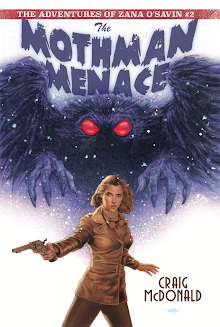The following is a re-presentation of a blog essay originally written for Lesa Holstine's sight in March, 2010 upon release
of PRINT THE LEGEND in hardcover.
The novel is now available for the first time in paperback (as well as eBook and audio formats).
_________________
Print the Legend is an historical thriller focused on the craft of writing and the strange or even sinister forces that can secretly shape or change the books we receive as readers.
“It’s a
dangerous thing to know a writer,” Ernest Hemingway warned.
Print the Legend features crime novelist Hector Lassiter,
who is popularly known as the “man who lives what he writes and writes what he
lives.” As that phrase implies, there is a strange, even chilling tension
between Hector’s life and the material in his novels.
Hector was
introduced in Head Games (2007), a tale
about the stolen and still-missing head of Mexican revolutionary Francisco
“Pancho” Villa and the Bush family dynasty’s possible ties to the missing
skull. That novel established that Hector had a long and storied friendship
with Ernest Hemingway, extending back to the First World War and their mutual
service as ambulance drivers on the Italian front.
Toros & Torsos (2008),
featured Hemingway as an on-the-page character, moving with Hector through Key
West in the run up to the killer 1935 hurricane that ravaged the middle Keys. Toros then tracks Hem and Hector into
Madrid and the ruins of the Spanish Civil War, charting the growing
estrangement between Hemingway and novelist John Dos Passos. T&T’s final pages introduced Hem’s
fourth wife, Mary, setting the stage for my new novel.
Print the Legend explores the death of Hemingway in
Ketchum, Idaho, in the summer of 1961, and raises questions regarding the
possibility that Hem’s death was something other than an act of suicide.
The novel also
explores J. Edgar Hoover’s obsessive and often destructive surveillance of key
American writers, including not just Hemingway, but Carl Sandburg, Pearl S.
Buck, John Steinbeck, Robert Frost, Rex Stout, Sinclair Lewis, William Faulkner
and Dorothy Parker, among many others.
Because Hector
is a novelist and screenwriter by trade, writing and the creative arts are
running themes through the series. Print
the Legend however, is the Lassiter novel in which I wanted to focus
squarely on the act of writing. To that end, I peppered Print with several very different kinds of authors.
The Lassiter
series is also intended as a secret history of the 20th Century. As
this novel is set largely in the 1960s — a decade of change, if there ever was
one — in Print I wanted to position
Hector against two very different and formidable kinds of women.
In addition to
Hemingway and Hector, we have Mary Welsh Hemingway — Papa’s fourth and final
wife. Mary was a war correspondent whom Hem began courting while still married
to journalist/novelist Martha Gellhorn. Hem and Mary’s marriage, while more
enduring, was no happier than Hem’s life with Martha.
When Hemingway
died, Mary became Hem’s unlikely literary executrix — actually editing (and
substantially altering) Hem’s manuscripts for A Moveable Feast and Islands
in the Stream…designing dust jackets and selecting titles for both books.
(Note: A Moveable Feast has in fact
just been reissued in a “restored” version by Hem’s grandson, purporting to
present the memoir as left by Hemingway, and enumerating the many changes and
alterations introduced by Mary.)
Mary Hemingway’s
still controversial “editing” of Feast is a key plot element of Print the Legend.
Print also introduces us to Hannah Paulson, a promising young
fiction writer who is very pregnant and increasingly troubled by the behavior
of her husband, Richard, a Hemingway scholar with a growing drinking problem
and this notion Mary murdered her
famous husband. Richard has agreed to write Mary’s biography as a means of
building his case against Mary as Papa’s killer.
As Hannah finds
herself questioning “the way of the writer” as represented by Mary, Richard and
an Idaho-town full of Hemingway scholars, she is increasingly drawn to Hector
Lassiter — a working novelist who seemingly lives on his own terms…a man who
embodies the writing life with a kind of seductive panache.
Print the Legend, in a sense, is Hannah’s book even more
than it is Hector’s. Through Hannah, we explore the strange and tragic arc of
Hemingway’s rise and fall as the premier stylist of his generation. Hannah
provides harrowing glimpses into the creative process and the destructive
shadow play that can result when authors and scholars become too cozy.
It is Hannah,
also, who is forced by circumstances to display that quality of “grace under
pressure,” Hem so fretted over. This comes in a scene I wrote as a kind of
homage to Hemingway’s wrenching birth scenes in the short story “Indian Camp,”
and Hemingway’s second novel, A Farewell
to Arms.
The other key
writer in this cast of authors is an FBI agent/thriller writer named Donovan
Creedy. Inspired by novelist/spy/Watergate plumber E. Howard Hunt, Creedy
stands in for a tiny army of FBI agents who actually followed, spied on and
haunted Hemingway through his final decades.
Those around
Hemingway — those who stood close witness to his steep physical and mental
decline — were convinced Hem’s obsession with FBI surveillance was another
symptom of his growing mental instability…straight-up paranoia.
Indeed, that
very attitude was a factor in Mary Hemingway’s approval of the electroshock
treatments that arguably hastened Hem’s destruction.
Following
Hemingway’s death, requests made under the Freedom of Information Act opened up
countless FBI documents (many still heavily redacted) that proved conclusively
the FBI was tracking Hemingway and
followed him right into the Mayo Clinic…reportedly perhaps even consulting
directly with Hem’s doctors.
Hoover, too,
left behind countless memos regarding Hemingway, revealing Hem was a kind of
obsession of Hoover’s, particularly moving forward from the late 1930s.







































No comments:
Post a Comment